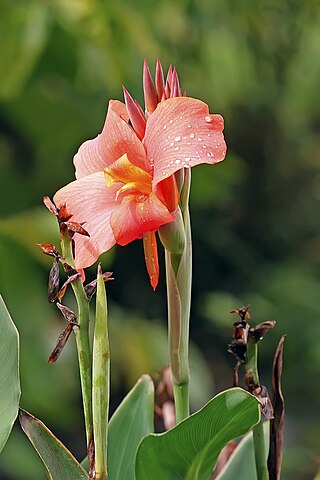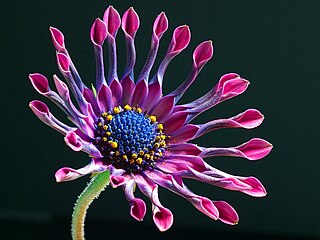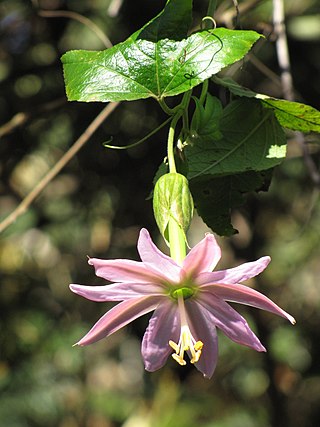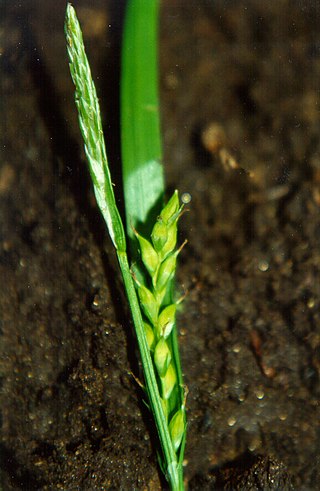Related Research Articles

Canna or canna lily is the only genus of flowering plants in the family Cannaceae, consisting of 10 species. All of the genus's species are native to the American tropics and naturalized in Europe, India and Africa in the 1860s. Although they grow native to the tropics, most cultivars have been developed in temperate climates and are easy to grow in most countries of the world, as long as they receive at least 6–8 hours average sunlight during the summer, and are moved to a warm location for the winter. See the Canna cultivar gallery for photographs of Canna cultivars.

Liberty Hyde Bailey was an American horticulturist and reformer of rural life. He was cofounder of the American Society for Horticultural Science. As an energetic reformer during the Progressive Era, he was instrumental in starting agricultural extension services, the 4-H movement, the nature study movement, parcel post and rural electrification. He was considered the father of rural sociology and rural journalism.

A cultivar is a kind of cultivated plant that people have selected for desired traits and when propagated retain those traits. Methods used to propagate cultivars include division, root and stem cuttings, offsets, grafting, tissue culture, or carefully controlled seed production. Most cultivars arise from purposeful human manipulation, but some originate from wild plants that have distinctive characteristics. Cultivar names are chosen according to rules of the International Code of Nomenclature for Cultivated Plants (ICNCP), and not all cultivated plants qualify as cultivars. Horticulturists generally believe the word cultivar was coined as a term meaning "cultivated variety".

The dewberries are a group of species in the genus Rubus, section Rubus, closely related to the blackberries. They are small trailing brambles with aggregate fruits, reminiscent of the raspberry, but are usually purple to black instead of red. Alternatively, they are sometimes referred to as ground berries.

Abutilon × hybridum is a species name used for a wide variety of different types flowering plants of uncertain origin in the genus Abutilon. Because of the uncertainty surrounding the name, they are often considered a cultivar group: Abutilon x Hybridum Group or Abutilon Hybridum Group. They are cultigens, not occurring in the wild. As with the larger genus Abutilon generally, they have been referred to by the common names Chinese lantern, and parlour maple.
The International Code of Nomenclature for Cultivated Plants (ICNCP) is a guide to the rules and regulations for naming cultigens, plants whose origin or selection is primarily due to intentional human activity. It is also known as Cultivated Plant Code. Cultigens under the purview of the ICNCP include cultivars, Groups, and grexes. All organisms traditionally considered to be plants are included. Taxa that receive a name under the ICNCP will also be included within taxa named under the International Code of Nomenclature for algae, fungi, and plants, for example, a cultivar is a member of a species.

Passiflora tarminiana is a species of passionfruit. The yellow fruits are edible and their resemblance to small, straight bananas has given it the name banana passionfruit in some countries. It is native to the uplands of tropical South America and is now cultivated in many countries. In Hawaii and New Zealand it is now considered an invasive species. It was given the name banana passionfruit in New Zealand, where passionfruit are also prevalent. In Hawaii, it is called banana poka. In its Latin American homeland, it is known as curuba, curuba de Castilla, or curuba sabanera blanca (Colombia); taxo, tacso, tagso, tauso (Ecuador); parcha, taxo (Venezuela), tumbo or curuba (Bolivia); tacso, tumbo, tumbo del norte, trompos, tintin or purpur (Peru).
A cultigen or cultivated plant is a plant that has been deliberately altered or selected by humans. Cultigens result from artificial selection. These plants have commercial value in horticulture, agriculture or forestry. Because cultigens are defined by their mode of origin and not by where they grow, plants meeting this definition remain cultigens whether they are naturalised, deliberately planted in the wild, or grown in cultivation.
A horticultural flora, also known as a garden flora, is a plant identification aid structured in the same way as a native plants flora. It serves the same purpose: to facilitate plant identification; however, it only includes plants that are under cultivation as ornamental plants growing within the prescribed climate zone or region. Traditionally published in book form, often in several volumes, such floras are increasingly likely to be produced as websites or CD ROMs.

Cultivated plant taxonomy is the study of the theory and practice of the science that identifies, describes, classifies, and names cultigens—those plants whose origin or selection is primarily due to intentional human activity. Cultivated plant taxonomists do, however, work with all kinds of plants in cultivation.

Mimusops elengi is a medium-sized evergreen tree found in tropical forests in South Asia, Southeast Asia and northern Australia. English common names include Spanish cherry, medlar, and bullet wood. Its timber is valuable, the fruit is edible, and it is used in traditional medicine. As the trees give thick shade and flowers emit fragrance, it is a prized collection of gardens.

Agave is a genus of monocots native to the hot and arid regions of the Americas and the Caribbean, although some Agave species are also native to tropical areas of North America, such as Mexico. The genus is primarily known for its succulent and xerophytic species that typically form large rosettes of strong, fleshy leaves. Agave now includes species formerly placed in a number of other genera, such as Manfreda, ×Mangave, Polianthes and Prochnyanthes.

Bongardia is a very small genus of plants belonging to the family Berberidaceae, and first described in 1831. There are only two known species, Bongardia chrysogonum C.A.Mey., native to North Africa, Greece, and the Middle East and B. margalla R.R.Stewart ex Qureshi & Chaudhri, native to Pakistan. The genus was monotypic until 1996, when the Pakistani populations were recognised by Govaerts as belonging to a second, distinct species.

George Francis Atkinson was an American botanist and mycologist.
Rubus alumnus is a North American species of highbush blackberry in section Alleghenienses of the genus Rubus, a member of the rose family. It is native to eastern and central Canada and the eastern and central United States.
Rubus blanchardianus is a rare North American species of flowering plant in the rose family. It has been found only in the State of Vermont in the northeastern United States.
Charles Stewart Parker was head of the Department of Botany at Howard University. He carried out the first systematic study of American species of the fungal genus Hypholoma and also collected over 2000 plant specimens, including several new species.
Carex densa is a tussock-forming species of perennial sedge in the family Cyperaceae. It is native to western parts of North America.

Carex donnell-smithii is a tussock-forming species of perennial sedge in the family Cyperaceae. It is native to parts of Mexico and Central America.

Carex hendersonii, also known as Henderson's sedge or carex de Henderson, is a tussock-forming species of perennial sedge in the family Cyperaceae. It is native to western parts of North America.